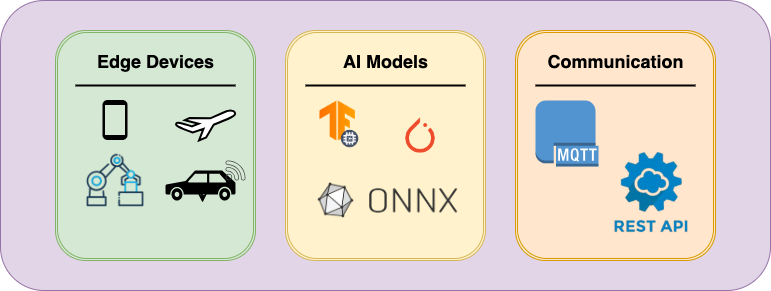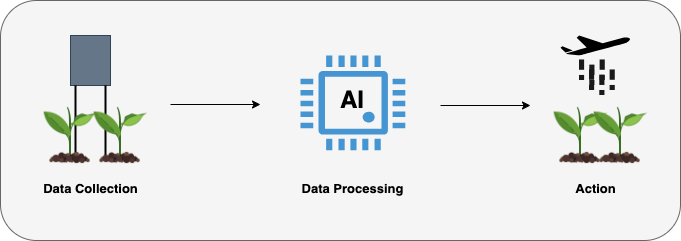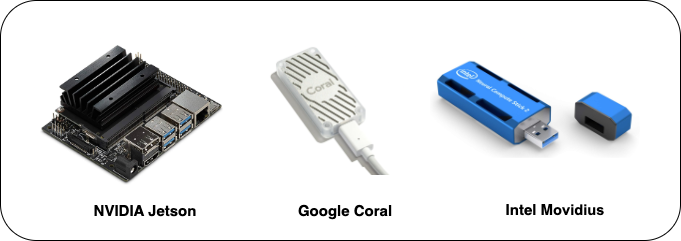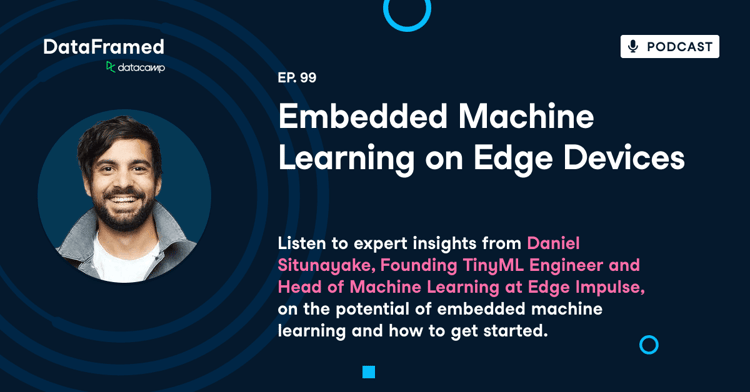Track
Artificial Intelligence (AI) is so powerful, but it often relies on remote cloud servers for its heavy lifting. This approach can be problematic for applications needing quick responses or those on devices with limited resources.
Imagine a self-driving car waiting for a cloud server to decide which lane to switch into—not ideal!
Edge AI solves this by bringing the AI capabilities directly to the device itself.
Become an ML Scientist
What Is Edge AI?
Edge AI is the practice of deploying AI models and algorithms directly on edge devices, which are devices located at the network's periphery, close to where data is generated and actions need to be taken.
These devices encompass a wide range, from powerful edge servers to resource-constrained IoT sensors, and include familiar examples like smartphones, smart home appliances, autonomous vehicles, and even industrial robots.
Recent advancements in AI, such as the development of smaller and more efficient language models like GPT-4o Mini, Llama 3.1 8B, and Gemma 2 2B, are further accelerating the adoption of edge AI.
This shift to edge AI offers several advantages:
- Speed: Decisions and actions happen in real-time, right where the data is generated. This is necessary for applications like self-driving cars or medical devices that can't afford delays caused by sending data to the cloud for processing.
- Privacy: Sensitive data can be analyzed locally without needing to be sent to the cloud, enhancing security and privacy.
- Reliability: Edge AI reduces dependency on a constant internet connection, making it more reliable in areas with limited or unstable connectivity.
- Efficiency: Processing data locally reduces the bandwidth required to send everything to the cloud, saving both energy and costs.
How Edge AI Works
To understand how edge AI works, we need to understand its main components and the processes involved.
Key components
Edge AI comprises three main components: edge devices, AI models, and communication.

Edge devices
Edge devices encompass a wide range of hardware, from powerful edge servers capable of handling substantial computational loads to highly resource-constrained IoT sensors designed for specific tasks.
These devices include smartphones, drones, autonomous vehicles, industrial robots, and smart home devices, all of which can run AI models locally to process data in real time. Some hardware manufacturers, like NVIDIA and Intel, even provide hardware support for deploying ML models on the edge.
AI models
Edge AI employs various types of AI models, including machine learning, deep learning, and computer vision algorithms, optimized for efficient execution on edge devices.
These models are tailored to operate within the constraints of edge environments, ensuring that they can perform effectively despite limited processing power, memory, and storage.
For instance, models like GPT-4o Mini and Llama 3.1 8B are specifically designed to be lightweight and efficient, making them suitable for edge deployments.
Communication
Efficient data exchange between edge devices and the cloud is facilitated by communication protocols such as MQTT and REST APIs. These protocols enable seamless connectivity and data transfer, allowing synchronized operations between edge devices and central systems when necessary. These protocols allow the transfer of information in compressed form in an almost lossless fashion to keep the crucial information intact.
MQTT (Message Queuing Telemetry Transport) is a lightweight messaging protocol designed for constrained devices and low-bandwidth, high-latency, or unreliable networks. It uses a publish-subscribe model, allowing devices to send (publish) and receive (subscribe) messages without needing a direct connection. This makes MQTT ideal for IoT applications where devices need to communicate efficiently and reliably.
REST API (Representational State Transfer Application Programming Interface) is an architectural style for designing networked applications. It uses HTTP requests to access and use data. REST APIs are stateless, meaning each call from a client to a server must contain all the information the server needs to fulfill that request. This makes REST APIs scalable and suitable for various web services and applications, including those involving edge devices.
The Process
The workflow that powers edge AI involves three steps: data collection, data processing, and action.

Data collection
Edge devices continuously collect data from sensors, cameras, or other sources, providing a steady stream of information. This data can range from environmental metrics and health parameters to video feeds and audio recordings, forming the basis for real-time analysis.
A great example of data collection is how your smartwatch collects the number of steps you took today.
Data processing
AI models deployed on edge devices process the collected data locally. This step involves analyzing the data to extract meaningful insights, detect patterns, and make predictions using AI models without relying on cloud resources.
Local processing ensures that decisions can be made quickly, such as a self-driving car determining which lane to choose in real-time.
Real-Time Action
Based on the AI model's output, edge devices can take immediate action. These actions might include triggering alarms, adjusting the path, or sending data to the cloud for further analysis. The ability to act in real-time is essential for scenarios requiring instant responses, such as security systems or medical devices.
Real-World Applications of Edge AI
Edge AI is transforming various industries by enabling real-time intelligence and decision-making. Let’s explore a few notable applications.
Manufacturing
In manufacturing, equipment downtime can be costly. Edge AI addresses this by monitoring equipment health and predicting potential failures before they occur. By analyzing data from sensors in real time, AI models can detect anomalies and alert maintenance teams to take preventive actions. This not only reduces downtime but also extends the lifespan of machinery.
Ensuring product quality is paramount in manufacturing. AI-powered cameras equipped with edge AI can inspect products for defects in real time. These systems analyze visual data to identify flaws such as scratches, dents, or incorrect assembly. By automating the inspection process, manufacturers can achieve higher accuracy, consistency, and efficiency, ultimately enhancing product quality and customer satisfaction.
Healthcare
The healthcare industry is benefiting significantly from Edge AI. Portable devices equipped with edge AI can analyze medical images such as X-rays, MRIs, and CT scans, providing faster diagnoses. This capability is particularly valuable in remote or underserved areas where access to specialized radiologists may be limited. By processing images locally, edge AI reduces the time needed for diagnosis, enabling timely treatment and improving patient outcomes.
Wearable devices with edge AI are revolutionizing patient care by enabling continuous monitoring of health parameters. These devices collect data such as heart rate, blood pressure, and glucose levels, analyzing it in real-time to detect anomalies. If a critical condition is identified, the device can alert healthcare providers immediately. This proactive approach to patient monitoring helps manage chronic diseases, detect health issues early, and reduce hospital visits.
Retail
Efficient inventory management is crucial for retail businesses. AI-powered cameras and sensors can track inventory levels in real time, ensuring shelves are always stocked. By analyzing data from these devices, edge AI can optimize stock replenishment, reduce waste, and prevent stockouts. This leads to improved customer satisfaction and lower inventory costs.
Understanding customer behavior is key to delivering personalized shopping experiences. Edge AI analyzes data from in-store cameras and sensors to gain insights into customer preferences and behavior. Based on this analysis, it can deliver tailored recommendations and promotions to individual shoppers. Personalization enhances the shopping experience, increases customer loyalty, and boosts sales.
Smart cities
Managing urban traffic is a complex task that requires real-time data analysis. Edge AI can optimize traffic flow by analyzing data from traffic cameras, sensors, and GPS devices. By detecting congestion patterns and predicting traffic conditions, it can adjust traffic signals, reroute vehicles, and provide real-time traffic updates to drivers. This improves traffic efficiency, reduces travel time, and enhances road safety.
Ensuring public safety is a top priority for smart cities. AI-powered surveillance systems equipped with edge AI can monitor public spaces, detect anomalies, and identify potential threats. These systems analyze video feeds in real time, recognizing suspicious activities such as unauthorized access or unattended bags. By alerting authorities promptly, edge AI enhances security and enables rapid response to incidents.
Edge AI: Hardware and Software Solutions
Implementing Edge AI requires the right combination of hardware and software solutions. Here are some popular options:

Hardware Platforms
To successfully implement Edge AI, you'll need suitable hardware platforms capable of running AI models efficiently at the edge. Let’s explore a few options:
- NVIDIA Jetson: NVIDIA Jetson is a powerful platform for AI at the edge, offering high-performance computing capabilities. It is widely used in applications such as robotics, smart cities, and healthcare. Jetson devices provide the processing power needed to run complex AI models locally, making them ideal for edge AI deployments.
- Google Coral: Google Coral devices are designed for fast and efficient edge AI deployments. They provide accelerated machine learning inferencing capabilities, making them suitable for various applications, including computer vision and IoT. Coral devices are known for their ease of use and integration with popular AI frameworks.
- Intel Movidius: Intel Movidius is renowned for its energy-efficient performance, making it ideal for vision-based applications. It supports deep learning and computer vision workloads on edge devices, enabling real-time processing with minimal power consumption. Movidius chips are commonly used in drones, security cameras, and smart home devices.
Software Frameworks
In addition to hardware, robust software frameworks are crucial for developing and deploying Edge AI applications. Let’s explore a few options:
- TensorFlow Lite: TensorFlow Lite is a lightweight version of TensorFlow, optimized for mobile and edge devices. It allows developers to deploy machine learning models on resource-constrained devices efficiently. TensorFlow Lite supports a wide range of AI applications, from image classification to natural language processing.
- PyTorch Mobile: PyTorch Mobile enables the deployment of PyTorch models on mobile and edge platforms. It supports a variety of AI tasks, including computer vision, speech recognition, and recommendation systems. PyTorch Mobile is known for its flexibility and ease of integration with existing PyTorch workflows.
- ONNX (Open Neural Network Exchange): ONNX is an open-source format for AI models, allowing models to be transferred between different frameworks. It is particularly useful for edge AI because it enables the use of pre-trained models across various platforms, including TensorFlow, PyTorch, and others. ONNX Runtime is optimized for performance on edge devices, ensuring efficient execution of models.
- Edge Impulse: Edge Impulse is a platform specifically designed for edge AI development. It offers tools for data collection, model training, and deployment, simplifying the process of creating and deploying edge AI solutions. Edge Impulse supports a wide range of hardware platforms and provides an intuitive interface for developers.
Challenges and Considerations
While Edge AI offers numerous benefits, it also presents several challenges that need to be addressed:
- Limited resources: Running complex AI models on devices with limited processing power, memory, and storage is challenging. Developers must optimize models to balance performance and resource consumption, ensuring efficient execution on edge devices. Techniques such as model quantization, pruning, and knowledge distillation are commonly used to reduce the computational load and memory footprint of AI models.
- Power constraints: Edge devices, especially battery-powered ones, require energy-efficient AI algorithms and hardware. Ensuring long battery life while maintaining performance is crucial for the widespread adoption of Edge AI. Techniques such as low-power hardware design, energy-efficient algorithms, and dynamic power management are essential for minimizing power consumption without compromising on performance.
- Data security and privacy: Processing sensitive data at the edge necessitates robust security measures. Protecting data and ensuring compliance with regulations like GDPR are critical for maintaining user trust and preventing data breaches. Techniques such as encryption, secure boot, and trusted execution environments are commonly used to enhance data security and privacy in edge AI deployments.
Conclusion
Edge AI represents a significant shift in how we deploy and utilize artificial intelligence.
By bringing computation closer to data sources, Edge AI addresses the limitations of cloud-based AI, such as latency, privacy concerns, and bandwidth costs.
Advancements in hardware and software, including the development of smaller, more efficient AI models, are driving the growth of Edge AI across various industries.
Edge AI promises a future where intelligent devices and applications seamlessly integrate into our daily lives, making them faster, safer, and more responsive.
Earn a Top AI Certification
Senior GenAI Engineer and Content Creator who has garnered 20 million views by sharing knowledge on GenAI and data science.


